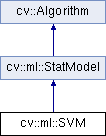opencv3.3 svm的使用
来源:互联网 发布:8寸windows平板 编辑:程序博客网 时间:2024/05/21 16:46
在OpenCV 3.3中取消了CvSVM类的定义,结构变成了这样的了:

具体可参考文档:
http://docs.opencv.org/3.3.0/d1/d2d/classcv_1_1ml_1_1SVM.html#a77d9a35898cae44ac9071c4b35bc96a8下边将OpenCV老版本的例子用OpenCV3.3的重新写了一下,亲测通过:
#include <iostream>#include <stdio.h>#include <unistd.h>#include <stdlib.h>#include <string.h>#include <string>#include <dirent.h>#include <unistd.h>#include <vector>#include <sstream>#include <fstream>#include <sys/io.h>#include <sys/times.h>#include <iomanip> // setw()using namespace std;#include <opencv2/core/core.hpp>#include <opencv2/imgproc.hpp>#include <opencv2/highgui/highgui.hpp>#include <opencv2/ml/ml.hpp> // svm using namespace cv;int main(int argc, char** argv){cout << ">> ----" << "\n" << endl;int wid = 512;int hei = 512;Mat image = Mat::zeros(hei, wid, CV_8UC3);// Set up training data int labels[4] = {1, -1, -1, -1}; Mat labelsMat(4, 1, CV_32SC1, labels); float trainingData[4][2] = { {501, 10}, {255, 10}, {501, 255}, {10, 501} }; Mat trainingDataMat(4, 2, CV_32FC1, trainingData);Ptr<ml::SVM> svm = ml::SVM::create();// Type of a SVM formulation. See SVM::Types. Default value is SVM::C_SVCsvm->setType(ml::SVM::C_SVC); // Initialize with one of predefined kernels. See SVM::KernelTypes// Linear kernel. No mapping is done, linear discrimination (or regression) // is done in the original feature space. It is the fastest option. if (0)svm->setKernel(ml::SVM::LINEAR);else{svm->setKernel(ml::SVM::POLY);svm->setDegree(1.0); }// Termination criteria of the iterative SVM training procedure which // solves a partial case of constrained quadratic optimization problem. // You can specify tolerance and/or the maximum number of iterations. // Default value is TermCriteria(TermCriteria::MAX_ITER + TermCriteria::EPS, 1000, FLT_EPSILON );svm->setTermCriteria(TermCriteria(TermCriteria::MAX_ITER + TermCriteria::EPS, 1000, FLT_EPSILON));// train// The second parameter: int lyout. See:// cv::ml::SampleTypes has two values: ROW_SAMPLE, COL_SAMPLEsvm->train(trainingDataMat, ml::ROW_SAMPLE, labelsMat);Vec3b green(0,255,0), blue (255,0,0); // Show the decision regions given by the SVM for (int i = 0; i < image.rows; ++i) for (int j = 0; j < image.cols; ++j) { Mat sampleMat = (Mat_<float>(1,2) << i,j); // predict float response = svm->predict(sampleMat); if (response == 1) image.at<Vec3b>(j, i) = green; else if (response == -1) image.at<Vec3b>(j, i) = blue; }// Show the training data int thickness = -1; int lineType = 8; circle(image, Point(501, 10), 6, Scalar( 0, 0, 0), thickness, lineType); circle(image, Point(255, 10), 6, Scalar(255, 255, 255), thickness, lineType); circle(image, Point(501, 255), 6, Scalar(255, 255, 255), thickness, lineType); circle(image, Point( 10, 501), 6, Scalar(255, 255, 255), thickness, lineType);// Show support vectors thickness = 2; lineType = 8; // The method returns all the support vectors as a floating-point matrix, // where support vectors are stored as matrix rows. Mat SupportVectorsMat = svm->getSupportVectors(); for (int r = 0; r < SupportVectorsMat.rows; r++) { float* data = SupportVectorsMat.ptr<float>(r); cout << r << "" << data[0] << "" << data[1] << endl; circle(image, Point((int)data[0], (int)data[1]), 6, Scalar(255, 0, 255), thickness, lineType); }imshow("SVM Simple Example", image); // show it to the user waitKey(0);cout << "\n" << ">> ----" << endl;return 0;}注意代码中这几行:if (0)svm->setKernel(ml::SVM::LINEAR);else{svm->setKernel(ml::SVM::POLY);svm->setDegree(1.0); }如果核函数用ml::SVM::LINEAR,下边Mat SupportVectorsMat = svm->getSupportVectors();将无法正常输出支持向量。这并非BUG,官方解释:https://github.com/Itseez/opencv/blob/2.4/modules/ml/src/svm.cpp#L1531将所有支持向量压缩为了一个,这样做可以极大地优化线性核时的运行效率。
阅读全文
0 0
- opencv3.3 svm的使用
- opencv3.1中svm的使用范例
- OpenCV3中使用SVM
- OpenCv3.0+SVM的使用心得(一)
- OpenCv3.0+SVM的使用心得(二)
- OpenCv3.0+SVM的使用心得(一)
- OpenCv3.0+SVM的使用心得(二)
- opencv3 SVM
- OpenCV3.0或OpenCV3.1的SVM操作
- OpenCV3.0或OpenCV3.1的SVM操作
- OpenCV3.0或OpenCV3.1的SVM操作
- OpenCV3.0或OpenCV3.1的SVM操作
- OpenCV3.0 中SVM的使用方法
- 基于SVM的分类识别 opencv3.1.0
- 【OpenCV3.3】SVM与字符分类示例
- OpenCV3.3中支持向量机(Support Vector Machines, SVM)实现简介及使用
- opencv3.0-支持向量机(svm)使用介绍
- opencv3.1 svm(支持向量机)使用心得
- 【后缀数组】不可重叠最长重复子串
- Manthan, Codefest 17
- flume-ng+Hadoop实现日志收集
- Ubuntu14.04 telnet 服务安装
- 冒泡排序
- opencv3.3 svm的使用
- unity 收货币动画
- git使用方式
- C-COT核心思想
- C语言 getchar(),putchar()函数的使用
- yii2 之图片上传插件fileinput使用说明
- IDEA dao层“Could not autowired”(已用使用MapperScannerConfigurer扫描)
- jstl在jsp中比较的
- 学习笔记07


